Text

Can someone please explain to me WHY THE FUCK AN ELECTRONIC COPY OF A BOOK IS NOT ONLY THIS EXPENSIVE, BUT MORE SO THAN THE (SINGULAR) HARD COVER COPY!?
I could really use this for my final project but $40 are you fucking kidding me?.
0 notes
Text
Religious Matters
I wasn’t sure what to write about in regards to a unique cultural experience, given that, by and large, I found England to be so incredibly similar to the USA that the only obvious differences were small ones like the prevalence of chocolate + orange candies.
But then I remembered our visit to Westminster Abbey. For one, the use of such a location for tourism is something I wouldn’t have considered. Certainly the USA has historic and beautiful churches, and I did briefly stop inside Trinity Church in Boston while I was there. But the sheer touristic nature of Westminster Abbey was not something I expected. It makes sense, given the historic value of the church, but still.
Then, there was our guide. Now, in the USA, I would say religious talk that isn’t pro-Christian is pretty rare, and definitely taboo. So I found it notable that our guide for such a holy building didn’t seem to mind at all mentioning how nonsensical he found theological concepts like Purgatory, intercession of the Saints, or the Last Judgment to be. He was critical, dismissive, and otherwise irreverent of the faith. The only time he seemed to show genuine respect is when the clergymen called for a moment of silence.
In the US, this would have been very controversial, and I could see him losing his job over talk like that. But he felt quite confident in it.
#to be clear#im not religious either#though i do find it interesting#but still#i don't know how common this kind of irreverance is in the uk#but it was notable to me coming from smaller american towns
1 note
·
View note
Text
Independent Reviews 5 - The British Museum
As a history and art nerd, the British Museum was mandatory to visit. The British Museum is probably one of the largest collections of historic artifacts and art in the world. And the museum is infamous among anyone with a smattering of anti-colonial sympathies as an egregious collection of imperial loot. That’s what I knew going in.
But there was a thought I had. I’ve heard a lot that “there’s nothing British in the British Museum”. While obviously hyperbolic, I wanted to see just how much of the collection is genuinely from Britain, or at least Western/Northern Europe.
What I found was that there is an almost overwhelming amount of artifacts on display from Britain alone, let alone the sheer amount from Western Europe at large. I spent a good 2 hours just cruising the collections of the Ancient European, Roman Britain, Anglo-Saxon and Early Middle Ages, Medieval, Renaissance, and Early Modern exhibits. Not even taking the time to really read and just look at the artifacts. If I wanted to do that, I’d need a whole day and probably another one too if I wanted to study the artifacts.





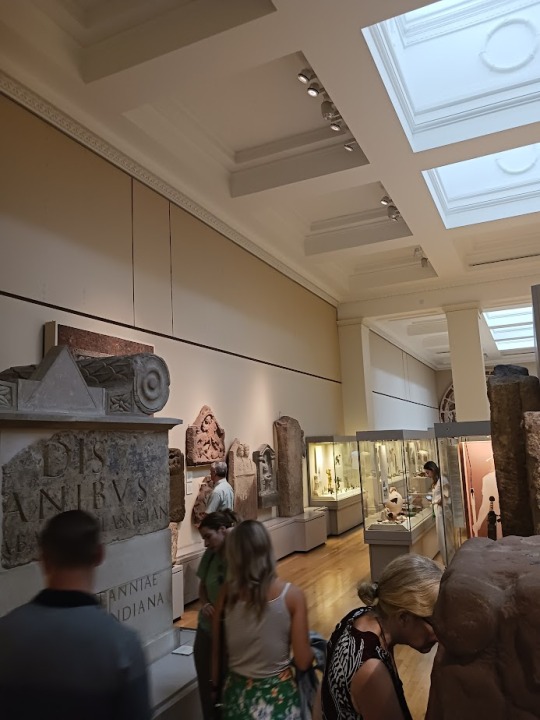

I took pictures of some of the collections, these are all ones from England, Britain, or Western Europe, all crowded together like this.
There was so much there that was British, English, or at least Western European. So much and it was crowded into a handful of rooms. How much better could I appreciate these artifacts if they gave back the stolen heritage here, and spread their artifacts out across the space instead? I saw the Sutton Hoo Helmet, the Battersea Shield, the Waterloo Helmet, I saw clasps and glass over a thousand years old. Beautiful crafts from England’s people going back millenia. Why isn’t that enough?


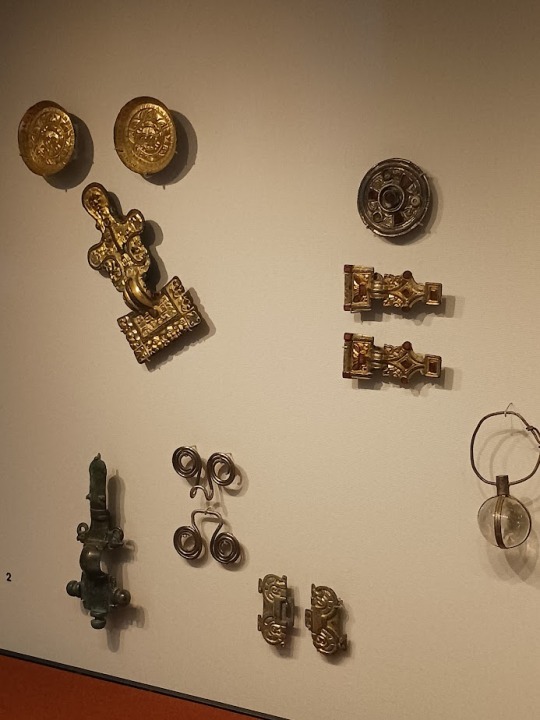

Anglo-Saxon artifacts, including the famous Sutton Hoo Helmet.
Something I’ve read a few times is that Britain and England especially is embarrassed by their history and culture, but it’s embarrassment isn’t the empire or the suffering, but the parts of their story they should cherish the most. Their folktales, their customs and quirks, their ancient artifacts, and their myths.
The British museum has said they can’t give back things like the Elgin Marbles or the Benin Bronzes or the Rosetta Stone because then their museum would be empty. But what I saw from Britain would take ages to truly appreciate. So is that what they think of Britain’s history? Of England’s millenia old history? That it’s nothing?
#genuinely i feel both sad for them and angry at the same time#YOU DARE HOARD OTHER PEOPLE'S HERITAGE AND HISTORY OVER AN INFERIORITY COMPLEX#its maddening#british museum#one thing i thought was intersting about England was how despite the English as a culture only dating back to the roughly 7th century#their history as a nation and a land is so much older#british empire#british history#england
2 notes
·
View notes
Text
Independent Reviews 4 - Gay’s the Word
I’m a terrible queer English major. I had no clue about the existence of this store, nor had I ever really gone to bookstores, LGTB+ or otherwise in the US at all, not even Powell’s when I lived in Portland for a few months. But I followed some classmates here, and I was quite happy I did. Gay’s the Word is the oldest queer bookstore in the UK, founded almost 20 years before I was born, and it was a great place to visit. Not only for its selection, but for its historic value. Albeit, the selection was good, and I bought three books here that, while maybe I could have gotten them in the US, I thought, screw it, let this place have my money.
The store had it’s history on the walls, with historic pins from the UK’s queer history, and books I know you’d never see anywhere near a ‘normal’ bookshop. Places like this are important for things like that. Also I like the tote bag I got there that says the shop name. It’s simple and blunt.

#I need to go to more bookstores#says the bitch who bought 17 books on this trip#but hey i was still under 50 pounds
0 notes
Text
Independent Reviews 3 - Camden Market & the Lara Croft Statue
I didn’t spend much time in Camden Market, wasn’t too much there that interested me… save one thing...




The Lara Croft Statue outside the Tomb Raider Live Experience was pretty much a pilgrimage site for me. There was no way I could go on this trip and not do something Tomb Raider related. Lara Croft Way in Derby was too out of the way, so this was the best I could do. I didn’t have time for the actual Experience (well, I did, but usually when I did, i needed time to rest, plus i didn’t wanna do it alone and was too awkward to ask anyone else to come along). Anyways, the statue was something I’d seen a lot of when it was first put up, and I so badly wanted to see it. And so when one of my classmates pointed it out to me, I ran. RAN. Jumped down the stairs towards it running, I had to get to it. It was… amazing. Being that close to a statue of a character that has meant so much to me my whole life, since I was like 4 years old... it was… astonishing. Amazing.
After we left, we toured the market for food, slipped into some lovely clothing shops, though I wasn’t interested in actual purchases. I took forever to find food, and settled on an Argentine burger stand. I got a burger with peppers and grilled onions and some kind of sauce IDK what it was, GOD thought that thing was good. I gotta start eating peppers with more things.
0 notes
Text
Independent Visit Reviews 2 - The Royal Crescent in Bath

While we did go here as part of the walking tour of Bath, a group of us ventured there quite a while earlier, and then went back yet again. It was one of my favorite parts of Bath. Our first day in Bath wasn’t that fun for me. I found the city obnoxiously crowded, suffocating, dirty, and overwhelming, especially after the Baths themselves with so many people packed into them. I hated the city within hours of being in it. Then a group of us went here the next morning, and it was… great.
I, for the first time in Bath, felt at peace, felt secure, felt something other than an everpresent annoyance. Now, there were some things I liked in Bath proper, the chocolate shop with sandwich cookies was amazing, and the Topping & Co. Bookstore was a wonderful place to chill at. But the Royal Crescent felt clean, it felt open, it felt right to me. It was a place of solace in an otherwise tumultuous city. It was shady, cool, and quiet.
#bath was such a mixed bag for me#the specific sites i liked#but the city overall was just too much for me#lmao I thought it looked a little like Paris when we got there and lo and behold Paris was the exact same except even worse
0 notes
Text
Independent Visit Reviews 1 - Bath Abbey

All of England’s old religious structures are amazing to visit, and one I popped into was Bath Abbey, in central Bath, just outside the Roman Baths. It’s a beautiful building, rich with traditional religious art motifs, and the standard overflow of graves and funerary plaques across the walls and floors that make English churches so interesting to me.

Something that struck me about the place is that, as ancient as it is (it even had a plaque dedicated to King Edgar the Peaceful, a 10th century King of England), the place was busy with people, active worship, and was a still functioning church by the looks of it. And that, to me, is amazing. That some so old was still in active use. There was a little corner where you could write a prayer, there were the votive candles, and while I’m far from religious, I could feel a desire in the place to create a religious connection.

5 notes
·
View notes
Text
Warwick Castle - A wonderland of medieval merriment on the outside, and a monument of empire on the inside


I think for many, the UK is synonymous with colonization and imperialism. Britain conquered ¼ of the planet, and dominated global politics during the 19th century. To this day, English/British culture is seen as standard in various nations across the planet (the three piece suit, the English language, handshakes as greetings). The ascendance of the United States, a former British settler colony has certainly aided in the continued influence of “British culture” over the world.
But empires and Great Britain have a history stretching back to Antiquity. When the vast Roman Empire invaded and subjected the Britons, forming the province of Britannia. And again when the Norse came, and settling the Danelaw or making England part of their empires (most notably the “North Sea Empire” under Cnut the Great), then the Normans and their conquest of the Kingdom, and subsequent French kings of England, and the so-called Angevin Empire. England’s conquests of Wales and Ireland, and finally the formation of the UK out of the personal union between England and Scotland. It’s been a long list of empires that rule in England, or Britain. And that history, especially the later parts of it, are not fun things to talk about, and can ignite harsh feelings in people…
When we visited Warwick Castle, it was easy to forget all the horrors. The place if lively, beautiful, and filled with things to to, from the hedge maze, climbing the towers (three cheers for Dr. Holl for finally getting to the top of the main tower after years of attempts), seeing the beautiful peacocks, visiting the food stalls, and little merchandise and toy shops, the joust event, the archery range (which had the hottest, most adorable man running it (Christopher if you see this, marry me :3c jk, unless…)) There’s just a lot to do and see and have fun with.
But as they day went on, I decided to go inside the main house. And there, I saw a different part of the castle. The outside is so fun, it’s like a theme park. The inside is more like a museum, and walking through its two halves, I was struck by a thought. I saw the gold portraits, and the fine silks and tapestries, and the dresses, and suits of armor, and the wax models lounging on sofas and I had a thought.
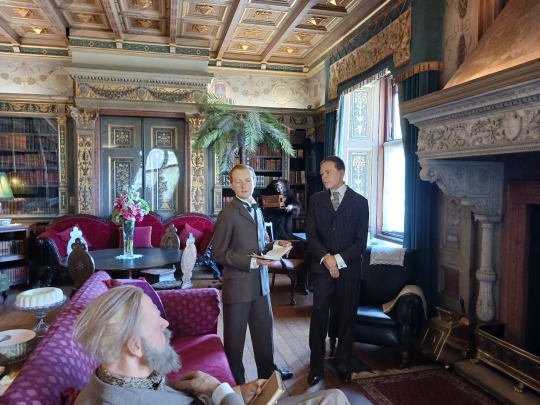
One of the models was a young Winston Churchill, whose tenure as PM saw a devastating famine in Bengal that killed millions.
What power, what wealth, these people must have had, to live here. How many have died because of them? How many lives have the owners of this castle throughout the centuries sent to their deaths? And for what?
The Wars of the Roses is a dramatic part of history, and the writings of William Shakespeare have helped turn it into such a story. But that story centers upon the feuding kings and dukes. And the things they fight about are just accepted as the way of things. England and her people were ruined, slaughtered by people squabbling over the question of who gets to own them. All of that happened right after the Hundred Years War, which saw England’s French kings fight for their supposed right to own France, because one Kingdom wasn’t enough for their greedy hearts. All these combatants were themselves descended from William of Normandy, who conquered England, toppled its native institutions, relegated English to a peasant language, and when people got agitated, who committed genocide to consolidate his rule. All because he thought he had a right to England and its people, as though they were an object to be owned.
Warwick Castle got its start with Æthelflæd of Mercia, as an Anglo-Saxon burh to defend against viking attacks, when England was still a fledgling nation, but the Normans came and made it a fortress, to ‘defend’ their rule. Just like the Kingdom of England would later do in Wales, and Ireland, just like the United Kingdom would do in America and India… follow the fortresses if you wanna follow the tide of Empire.
The way I see it, the Norman conquest turned England into an engine of empire, greased with the blood of the English people, and those it conquered alongside them. And that engine became the United Kingdom, and made an empire that spanned the globe. But the only real beneficiaries have been the same ones who caused the Wars of the Roses, the Hundred Years War, the Harrying of the North… the same kind of people that drafted Americans into the Vietnam War, who pushed Native Americans into pitiful reservations that they’ve starved of resources, who enslaved Africans for the profit of the cotton and tobacco trades. The rich and powerful and wealthy. Those who rule us. How cruel of a world it is, that we are ruled by people who see us as disposable because in their warped little heads, we are.

Fun fact about England's medieval standard, it's a quartering of France and England's CoAs, and France, in quadrants 1 and 4, was given the place of higher importance, because England's kings considered themselves French, and that France was more important.
#eat the rich my dearies#and don't think for one second that those of us in republics are free#americans are as disposable to their government and the english are to theirs#also i'm not trying to make the anglo-saxons look like saints#its just that we don't know as much about their way of rulership and it was far less developed than what would come centuries later#and given that they were on the defensive a lot their capacity for evil is less than post norman england's imo#warwick castle#england#uk#british empire
3 notes
·
View notes
Text
Fear and Fun - A Midsummer Night’s Dream and the unity of fear and comedy in fairies
‘Fairy’ is a name for a kind of magical being, found the folklores of various European nations, most notably those of the Anglo-Celtic Isles. They are known by numerous names, in many different languages. In England, fairies developed as a sort of unification of the Germanic elves (the terms “elf” and “fairy” are used interchangeably in folklore), and the Celtic fae. Both served as nature spirits.
In modern culture, fairies are fairly benign, harmless, and will grant wishes and help lost humans. It is, as far as my readings go, an invention of Victorian era folklore. For much of their history, fairies, elves, and other such beings could be as helpful as they were harmful. They were powerful, magical, and magnificent. Beings to be feared and respected, just as nature itself ought to be.

Poor little birdie teased, by Richard Doyle
As time went on they were anthropomorphised more and more, becoming trickster spirits and household helpers (so long as you paid them what their work was worth (all the side eye in the world to Rowling for depicting “house elves” as enthusiastic slaves, a status they would never have suffered)).
But where am I going with this? Well, the anthropomorphised form of trickster is what Robin Goodfellow, AKA Puck is. Puck being from English folklore, infamous for his pranks. That being was used by William Shakespeare for his play A Midsummer Night’s Dream. That same play was performed during our trip to England, at the Globe Theater.
The standout character of the play was by far Puck. They were easily the most memorable part of it all.
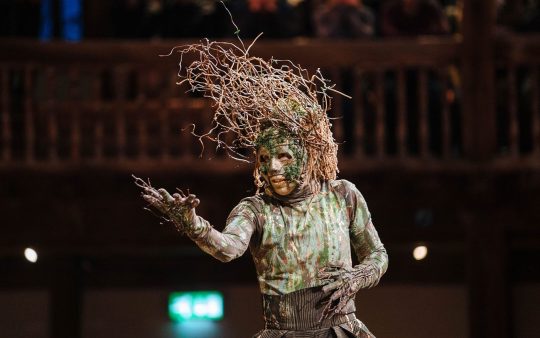
Michelle Terry, as Puck, in the current run at the Globe. Photograph by Hellen Murray
First appearing, rising up out of the floor, smoke billowing around, wailing, and running across the stage, cacophonous music accompanying them. Their face was masked by twigs, making them the most inhuman being in the play, the only one without a face.
Each time Puck’s magic was used, it was accompanied by a fearful stab of music, when they transformed Bottom especially.
But Puck was humorous, sarcastic, and playful in their conduct, just the character was written. They bantered with Oberon, “I go. [leaves and comes back] I GO! [leaves and comes back] I go!” The actor was the one who got the show back on track when the theater’s sprinklers malfunctioned, and drenched the floor audience, “This always happens!” They seemed to interact the most with reality, scribbling ‘ASS’ in an audience member’s notebook, at one point I remember them waving a plane away, as the noise from them kept interfering with the play.
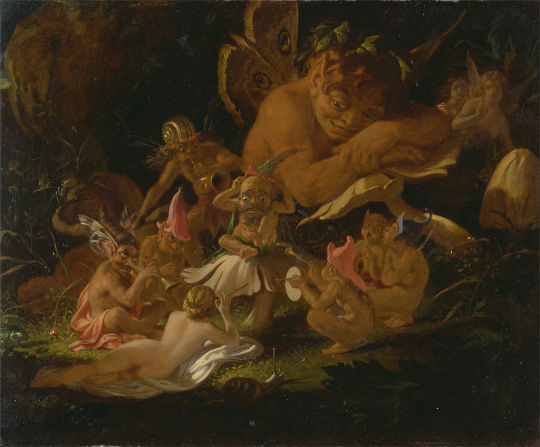
Puck and Faeries, Sir Joseph Noel Paton
I felt like the way they depicted Puck was a magnificent union of the way fairies are both playful and funny, and also horrifying and powerful. Puck was as scary as they were funny, and made such an incredible impression on me, that I was left thinking about it days, and now over a week later. It was a highlight of the entire trip and easily made this performance my favorite live play ever thus far.
#I don't remember if they changed Puck's pronouns to fit the actor like they did with Bottom#so I decided to just use they/them ones
2 notes
·
View notes
Text
ENGL 350 Blog 4
A Love Forged in the Fires of Hell…
Act 2 Scene 1’s exchange between Demetrius and Hermia is one of my favorites because it’s funny, pathetic, and all the while slightly uncomfortable when you think about what they’re doing and where they’re going.
It starts with Demetrius stating that he hates the pursuant Helena and then demonstrating what a love god he is with his plan to kill Hermia’s lover so she can be with him because that will definitely make her love him back. Helena, for her part, reiterates her want for Demetrius. Demetrius then says what every person who has ever been followed around by a weirdo has wanted to say to said person.
“Do I entice you? do I speak you fair? Or, rather, do I not in plainest truth Tell you, I do not, nor I cannot love you?”
But what agonizes me with this statement from Demetrius is that he is so in the right to say this to Helena… but then what the hell is he doing in these woods again? Oh yeah, pursuing Hermia, doing exactly the same thing to her that Helena is doing to him.
Helena responds to this by revealing her BDSM kink, stating that she is Demetrius’s spaniel, and that she would even be happy getting beaten senseless so long as it was his hand hitting her.
Demetrius’s response is pretty much the only one that makes sense to such a declaration.
“Demetrius: Tempt not too much the hatred of my spirit;
For I am sick when I do look on thee.
Helena: And I am sick when I look not on you.”
But Helena turns it back on him.
We then get to the bleakest part of this scene because yes, it does get worse thanks to Demetrius.
“You do impeach your modesty too much, To leave the city and commit yourself Into the hands of one that loves you not; To trust the opportunity of night And the ill counsel of a desert place With the rich worth of your virginity.”
Simply put, he threatens to rape her if she doesn’t leave…
Again, I want to sympathize with Demetrius, but the level of audacity to threaten that is… wow. It’s also a bit stupid considering she’s pretty much been begging him to do her for hours now. And indeed, her reply is pretty much, “I want you to.”
To everyone’s relief, Demetrius’s threat, though still heinous, was empty, or at least toothless, as he decides to just run away from her.
When he states so, we finally, finally, for the love of Christ our Maker, get some bite from Helena, in that she is so sick of trying to make Demetrius love her. That she should be the one getting wooed by him. Of course she still hasn’t gotten it through her thick skull that it would take a miracle to make that happen… oh wait.
Really though, the entire exchange is funny to me. But, it is also why the idea of Helena and Demetrius actually being together makes me want to vomit. The threat he gives is also ironic given that he’s the one who ends up getting… forced upon…
That irony honestly is what makes thing the ending of the play is meant to be a joke in and of itself. The only couple in the play that actually has some business together is Lysander and Hermia, but they are joined in the end with Thesus and Hippolyta, Demetrius, and Helena, as well as a renewed Oberon and Titania. It makes them stand in stark contrast as an ideal love surrounded by couples that should not be together. Perhaps a statement on marriage as a business of suffering more than a genuinely happy ending.
0 notes
Text
ENGL 306 Blog 4
Melodramatic Melancholy
The opening of George Eliot’s “The Lifted Veil” is honestly just great to me. “The time of my end approaches.” is quite a way to open a story, but I think the immediate desire Latimer feels for his own demise is what seals the idea for me. He spends so much time expressing his desire to die, “Unless, then, I am cursed with an exceptional physical constitution, as I am cursed with an exceptional mental character, I shall not much longer groan under the wearisome burthen of this earthly existence”.
In a way, I know the talk. My depressing friends and I had always said we don’t want to live too long lives, the desire for death and the disdain of life being strong in a group of edgy, mentally ill teenagers.
That Latimer knows his death for certain, down to the exact date, for he foresaw it in a vision is what makes the whole thing all the more interesting. “I shall be sitting in this chair, in this study, at ten o’clock at night, longing to die, weary of incessant insight and foresight, without delusions and without hope.” These visions he seems to have are a burden I suppose.
How he describes his coming death is an tangle of humor, depression, and I think a nice detail to human nature. When his death comes, he will ring a bell for his staff, despite knowing it won’t save him. The humor comes in with how it won’t save him.
“My two servants are lovers, and will have quarrelled. My housekeeper will have rushed out of the house in a fury, two hours before, hoping that Perry will believe she has gone to drown herself. Perry is alarmed at last, and is gone out after her. The little scullery-maid is asleep on a bench: she never answers the bell; it does not wake her.”
That kind of interpersonal drama is hilarious to me. A man is dying and he won’t be saved because of a lover’s quarrel and a deep sleeper. I laughed at that, and it’s the kind of gallows humor that really expresses Latimer’s conscious acceptance of this fate.
The detail I loved though is that despite his desire to die, as shown in the first two paragraphs, he really doesn’t.
“I make a great effort, and snatch at the bell again. I long for life, and there is no help. I thirsted for the unknown: the thirst is gone. O God, let me stay with the known, and be weary of it: I am content.”
He wants to die, and also knows that when the time comes he will grasp at life because no living soul wants to die, no matter how much it protests persisting.
0 notes
Text
ENGL 306 - Blog 3
Is Northanger Abbey Gothic? Or Bildungs-romanesque?
Jane Austen’s Northanger Abbey is described as a satire of Gothic literature. It features a precocious young lady, an avid reader of gothic novels, and puts her at odds with a reality that is not as fantastic as that of the Gothic genre. I think that descriptor is apt. While broadly, there are some Gothic elements the novel employs in earnest, namely in the innocent feminine character of Catherine, and her development; there are also many elements, like the trapped female, the murderous patriarch, and the melodrama that seem undercut with their lack of “real” foundation. That undercutting of Gothic tropes makes it a satire, in my eyes. In addition, it seems to lack the, in my eyes, crucial elements of entropy and the interventions of the supernatural and the past. Those omissions are needed for Cathrine’s character, as a bit of nerd for the Gothic, as someone who needs a little more… “growing”. To me, Northanger Abbey is less Gothic, as it is a coming of age story that plays with Gothic elements. The intermingling of Gothic and coming-of-age is notable I think, because in a way, I think growing up involves some elements of the Gothic. The decay of innocence, the shifting perceptions of those around you, and the way you come to realize just how much your past affects your present are key, and coalign with key elements of Gothic literature. Something dies in you, and is reborn into something newer, stranger. But that past that’s dead and buried does not lay at rest, and it will repeatedly come up in your mind, echo. Like when you meet an old friend for the first time in years, or how a trauma from elementary school binds you as an adult.
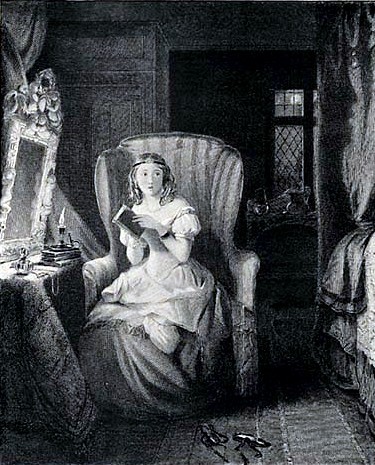
#lol this is soooo late#also intertwining gothic and growing up is a key part of my webcomic Welcome to Augustus#yes the title is an architecture pun
0 notes
Text
Probably gonna devote a larger, more comprehensive post to it, but...
I visited the British Museum, and spent 2 hours casually viewing the Medieval, Anglo-Saxon, Renaissance, Ancient European, and Enlightenment collections...
The idea that of they have gave everything back, they'd have nothing is bullshit.
They had more than enough
4 notes
·
View notes
Photo

Your daily dose of cat memes
3K notes
·
View notes
Text










One day in Paris is not enough to see all it has to offer... it's also the maximum I can tolerate.
1 note
·
View note
Photo

Your daily dose of cat memes
4K notes
·
View notes
Photo

Your daily dose of cat memes
6K notes
·
View notes